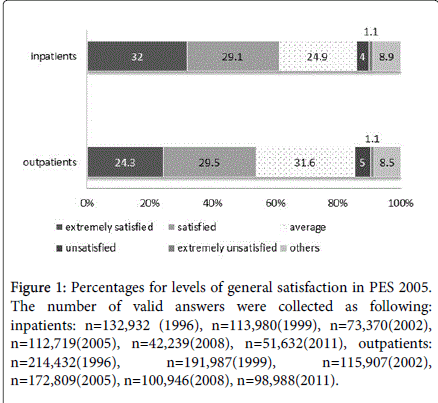Tomoko Kodama Kawashima, Eri Osawa, Etsuji Okamoto and Hiroko Miura
Introduction: Patient Experience is stressed more in the context of patient safety and patient-centered care. It is a crucial component in quality evaluation of healthcare. In Japan, Patient Experience Survey (PES) has been conducted at the national level in three-year intervals since 1996. We overviewed general satisfaction of patients in time- series and examined the factors associated with.
Methods: Open source data of PES from 1996 to 2011 were used to find time-series change in general patient satisfaction. For cross-sectional analysis, we examined the factors influencing patient satisfaction by using original PES data of 2005. Cronbach’s alpha was calculated for examining reliability of seven questions about patient satisfaction. Logistic regression analysis adjusted for age and sex was used for examining the associations with patient satisfaction and other factors.
Results: Overall rates of showing general satisfaction (extremely satisfied and satisfied) were gradually increased from 53.7% to 64.7% among inpatients, but less increase among outpatients from 48.1% to 50.4%. Seven questions on patient satisfaction in the questionnaire for both inpatients and outpatients, high reliability were confirmed with Cronbach’s alphas 0.895 and 0.863, respectively. The highest average score was found in satisfaction with care provided by nurse. Patients’ general satisfaction was highly related with satisfaction in good communication with physician (Pearson’s correlation coefficient; r=0.650, p<0.01). Among outpatients, satisfaction with the cost which patients paid on the day they visited had smaller correlation coefficients compared with other satisfaction variables (r=0.255-0.294). Respecting autonomy (patients decision was respected on treatment) had positive association with patient satisfaction (β=0.152, SE=0.031, p<0.001) and uncertainty of patient safety had negative association with patient satisfaction (β=-1.512, SE=0.052, p<0.001).

Figure 1: Percentages for levels of general satisfaction in PES 2005. The number of valid answers were collected as following: inpatients: n=132,932 (1996), n=113,980(1999), n=73,370(2002), n=112,719(2005), n=42,239(2008), n=51,632(2011), outpatients: n=214,432(1996), n=191,987(1999), n=115,907(2002), n=172,809(2005), n=100,946(2008), n=98,988(2011).
Conclusion: General satisfaction among patients has been stable or slightly improved over 15 years. Good communication with physician, respecting autonomy and patient safety should be recognized again to improve patient satisfaction.
PDFShare this article
Journal of Nursing & Care received 4230 citations as per Google Scholar report